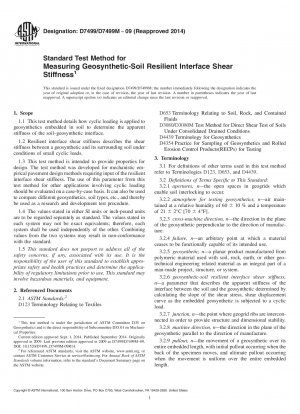ASTM D7499/D7499M-09(2014)
Standard Test Method for Measuring Geosynthetic-Soil Resilient Interface Shear Stiffness
- Standard No.
- ASTM D7499/D7499M-09(2014)
- Release Date
- 2009
- Published By
- American Society for Testing and Materials (ASTM)
- Status
- Replace By
- ASTM D7499/D7499M-09(2023)
- Latest
- ASTM D7499/D7499M-09(2023)
- Scope
5.1 This test method is intended as a performance test to provide the user with a set of design values for the test conditions examined.
5.1.1 The test method is applicable to all geosynthetics and all soils when loaded in a cyclic manner.
5.1.2 This test method produces test data, which can be used in the design of geosynthetic-reinforced pavement structures or in applications where geosynthetics are subjected to cyclic loads.
5.1.3 The test results may also provide information related to the in-soil stress-strain response of a geosynthetic under confined loading conditions.
5.2 Information derived from this test may be a function of soil gradation, plasticity, as-placed dry unit weight, moisture content, length and surface characteristics of the geosynthetic and other test parameters. Therefore, results are expressed in terms of the actual test conditions. The test measures the net effect of a combination of interface shear mechanisms, which may vary depending on type of geosynthetic specimen, embedment length, relative opening size, soil type, displacement rate, normal stress, and other factors.
5.3 Information between laboratories on precision is incomplete. In cases of dispute, comparative tests to determine if there is a statistical bias between laboratories may be advisable.
1.1 This test method details how cyclic loading is applied to geosynthetics embedded in soil to determine the apparent stiffness of the soil–geosynthetic interface.
1.2 Resilient interface shear stiffness describes the shear stiffness between a geosynthetic and its surrounding soil under conditions of small cyclic loads.
1.3 This test method is intended to provide properties for design. The test method was developed for mechanistic empirical pavement design methods requiring input of the resilient interface shear stiffness. The use of this parameter from this test method for other applications involving cyclic loading should be evaluated on a case-by-case basis. It can also be used to compare different geosynthetics, soil types, etc., and thereby be used as a research and development test procedure.
1.4 The values stated in either SI units or inch-pound units are to be regarded separately as standard. The values stated in each system may not be exact equivalents; therefore, each system shall be used independently of the other. Combining values from the two systems may result in non-conformance with the standard.
1.5 This standard does not purport to address all of the safety concerns, if any, associated with its use. It is the responsibility of the user of this standard to establish appropriate safety and health practices and determine the applicability of regulatory limitations prior to use. This standard may involve hazardous materials, and equipment.
ASTM D7499/D7499M-09(2014) Referenced Document
- ASTM D123 Standard Terminology Relating to Textiles
- ASTM D3080/D3080M Standard Test Method for Direct Shear Test of Soils Under Consolidated Drained Conditions
- ASTM D4354 Standard Practice for Sampling of Geosynthetics for Testing
- ASTM D4439 Standard Terminology for Geosynthetics
- ASTM D653 Standard Terminology Relating to Soil, Rock, and Contained Fluids
ASTM D7499/D7499M-09(2014) history
- 2023 ASTM D7499/D7499M-09(2023) Standard Test Method for Measuring Geosynthetic-Soil Resilient Interface Shear Stiffness
- 2009 ASTM D7499/D7499M-09(2014) Standard Test Method for Measuring Geosynthetic-Soil Resilient Interface Shear Stiffness
- 2009 ASTM D7499/D7499M-09 Standard Test Method for Measuring Geosynthetic-Soil Resilient Interface Shear Stiffness
